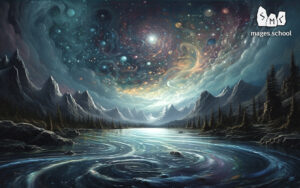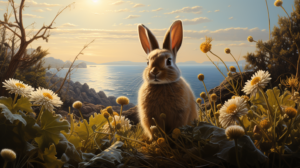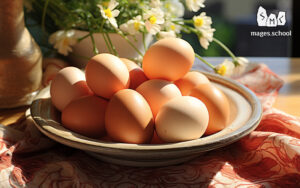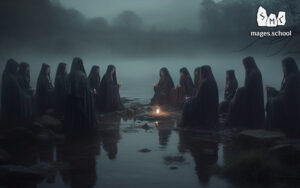Ostara
(Zhavoronki, Soroki, Komoeditsa)
March 20th-23rd. The Spring Equinox.
During this time, the Water Element awakens. As if awakened by Air, Water is directed ahead under the influence of the current, forming a space for what is destined to happen. Any action, any creation requires energy. that said, energy must be pure and infinite, the more the better. There exists such an energy and its essence is hidden in the Water Element – it is the energy of Chaos.
 The date of the spring equinox fluctuates, each year it needs to be calculated, though it is within a given interval, only the precise time changes. Just like with the previous holiday, the ritual actions for men and mages (priests, volkhvs, and druids) differed. The task of men is to feel the element, merge into it, and begin existing with it in the altered rhythm. The task of mages is to make it so that the Element does not see the participants of the ritual as foreign elements and includes the inner vibrations of the living into its own natural vibrations. To achieve this precise result, men – under the supervision of a mage – conducted ritualistic actions that symbolized the death of the old and the birth of the new – these are the exact functions that the power of Chaos carries within itself.
The date of the spring equinox fluctuates, each year it needs to be calculated, though it is within a given interval, only the precise time changes. Just like with the previous holiday, the ritual actions for men and mages (priests, volkhvs, and druids) differed. The task of men is to feel the element, merge into it, and begin existing with it in the altered rhythm. The task of mages is to make it so that the Element does not see the participants of the ritual as foreign elements and includes the inner vibrations of the living into its own natural vibrations. To achieve this precise result, men – under the supervision of a mage – conducted ritualistic actions that symbolized the death of the old and the birth of the new – these are the exact functions that the power of Chaos carries within itself.
Chaos is able to dissolve all within itself and it is also the material for the creation of something new. In this moment, man must become light and fluid, akin to water. He must not get attached to what is obsolete and act as a pebble inside your own shoe. The space that’s been cleared at the previous stage must be filled with new force, and water will wash out of life what’s been stuck to it against the will and desire of the person himself.
The burning of a dummy as part of the ritualistic action also symbolized the process of liberation from the old. The dummy was made from the previous year’s straw, winter rags, and – very importantly – grain from last year’s harvest were put into the dummy. Symbolically, this represented renouncing a pull towards hoarding: that which was taken from nature but did not come in handy now must be returned to its original form – the heat, the light, into the earth, and the ashes will be spread across the field of future harvest. The dummy in no way was meant to represent the winter gods or the gods of the dark realms. None of the humans who lived within the pagan paradigm could ever think of burning the symbol of, albeit a dark, god thus showing disrespect towards Death. One could simply not survive till next winter for such thoughts, let alone actions.
A ritual is a process, and it takes time. It is impossible to conduct a ritualistic action casually, in parallel with other affairs. This is why on this day, just like on other cult holidays, people would leave their current tasks no matter how important they are: wars would come to a halt, and arguments would cease. People wouldn’t get distracted by domestic matters, which formed the basis of people’s idioms, superstitions, and beliefs. The magical moment of the addition of the power of the awakened Water for the mages of antiquity was based on the fact that together with the force of creation, contact with gods was established, the power and might of whom helped people not just survive but live in wealth. Wealth lies within the gifts of Earth and her ability to give birth and feel all her children. Precisely this property of Earth as a Mother, young in her awakening, ready to give birth and to feed, free of any morality or limitations, was venerated by the ancient ones on the day of the arrival of spring.
The goddesses from different pantheons of ancient cultures were worshiped during Ostara as each land has its own gods: Aphrodite, Astarte, Demeter, Hathor, Ishtar, Kali, Ostara (Eostre), Frejya, and Lelya. All of them are symbols of freedom and the power of fertility when the sensation of life gives rise to hope. On the day of the spring equinox, when the night is equal to day, life is equal to death. Entering this time period, this knowledge becomes pronounced in the consciousnesses of the living, as if revealing for people the transience of life and saying, “People, live in the here and now, don’t get stuck”.
The awakened Air awakened Water, and together they kickstart the turning of the Wheel – time has started. This is why the true new year for people begins exactly on this day – on the day of the Spring Equinox. The celebration of the arrival of spring is the celebration of time which people will now definitely have. For mages, volkhvs and druids started earlier on Imbolc. The tradition sets it for them that the consciousness must be in sync with those among whom their magical mind lives, not their human body. With their bodies, the volkhvs and the druids are with people, but with their minds, they are with the spirits. The main symbols of the holiday of the young Maiden-goddess are a rabbit and an egg.
 A rabbit is the symbol of fertility for when the ancient ones worshiped the Tri-faced Goddess of the moon often saw an image of a rabbit on the face of the full moon. Many of the ancient moon gods had a rabbit as their symbol. The occult meaning of this symbol is rebirth, return to youth, and also intuition, and “light in the darkness.” Very often, a rabbit is associated with sacrificial fire and “life that’s passed through death.” Universally, the rabbit is a symbol of fertility, not of man but rather fertility of nature. Only in Christianity, a rabbit is a symbol of fornication and satanic lust, whereas in the Judaic culture, a rabbit is an impure animal.
A rabbit is the symbol of fertility for when the ancient ones worshiped the Tri-faced Goddess of the moon often saw an image of a rabbit on the face of the full moon. Many of the ancient moon gods had a rabbit as their symbol. The occult meaning of this symbol is rebirth, return to youth, and also intuition, and “light in the darkness.” Very often, a rabbit is associated with sacrificial fire and “life that’s passed through death.” Universally, the rabbit is a symbol of fertility, not of man but rather fertility of nature. Only in Christianity, a rabbit is a symbol of fornication and satanic lust, whereas in the Judaic culture, a rabbit is an impure animal.
A rabbit on the moon appears in mythology pretty ubiquitously and being a lunar animal along with a dog and a lizard, it serves as an intermediary between man and the lunar deities. In Scandinavian mythology, rabbits serve Frejya. The Egyptian god of the moon Osiris was a symbol of moral purity in his rabbit hypostasis. An egg represents the cosmic egg of creation. Life that is at the stage of being created: it already exists, yet not quite. An absolutely magical state of primordial creation, when it is still possible to embed the needed qualities in the future reality in a way that when this reality is manifested those qualities become inseparable from it. The Easter tradition of painting the eggs takes its origin in the ancient symbolism of the goddess of Life, the youthful hypostasis of Mother Earth. The people of ancient times, painting the egg, each “decorated” it with their dream-hope. Each person drew that type of life on the future of his reality that he wanted for himself. But never did people boil the painted egg, let alone eat it. The painted eggs were meant as offerings to the goddess of Spring and Life. A boiled egg means dead life, killed hope – a life that could have been but will never be. To eat it means to sacrifice your killed dream in favor of that tradition that denies life and venerates death. The smashing of eggs is a symbolic fight between the men, where a victory means that the winner’s dream will come to pass, and the loser’s dream will not. In practice, this means whether or not, the dead sacrifice is accepted by the dead god. A painted egg is a letter, a message. A request to the goddess of Life to take into account the dreams of a person in the destiny of the upcoming year.
 The structure of an egg as a symbol of future life, finished in its formation, but not yet manifested completely possesses all the qualities of elemental powers: the shell is the Earth, the protein is Water, the egg yolk is Fire, the Air cell is the space of Air. A small Universe, a finished reality – this is how an egg was viewed by the ancient ones. For mages, an egg was a symbol of tradition – a finished system that has the potential to become alive.
The structure of an egg as a symbol of future life, finished in its formation, but not yet manifested completely possesses all the qualities of elemental powers: the shell is the Earth, the protein is Water, the egg yolk is Fire, the Air cell is the space of Air. A small Universe, a finished reality – this is how an egg was viewed by the ancient ones. For mages, an egg was a symbol of tradition – a finished system that has the potential to become alive.
Such a magical structure of an egg is a universal mechanism for transferring information. This is why, since the dawn of time and till the present day, witches use eggs to remove negativity, and get rid of illnesses, scares, and other misfortunes, the reasons for which have an informational basis (an event, a whispered word, a performed spoilage, etc.). Only in the case of extraction of the negative program and transferring of it via special words (nagovor) onto an egg, it is sent not to the gods of life but to the gods of death (it is buried into earth, entombed in a swamp or planted at the cemetery, and so on).
For certain magical lineages of druids, eggs were considered sacred and were therefore considered forbidden to consume as food. The magical rituals on the day of the spring equinox that were performed by the magi and druids on the power of awakening Water differed from those performed by people. The rituals of magicians are one step ahead compared to people. The filling of the future reality with information was all completed at the previous stage on Imbolc. However, the mages of the old times never did this “reality programming” out of their small-scale human passions, fears, and hopes – these things aren’t present anymore in the consciousnesses of those who first greet the guests from the in-between worlds. The information regarding the future comes from the creator-gods of reality, and the mages, magi, and druids let this knowledge pass through their empty consciousness, liberated beforehand from all that is human and passing this knowledge to the world in an unchanged form – through breathing, through the power of wind and a secret Word, which is said to the Wind. This information arrives with the winds of Imbolc and comes out with the Waters of Ostara. In the consciousness of a mage, only pure knowledge remains – being able to foresee the future. He (a mage) did not hide anything when passing this knowledge to the Water, and he did not add anything extra from himself.
 People, unlike mages, priests, magi, and druids, have the right to think not of the entire humanity but only of themselves. On Ostara, they repeat the step that was done by the mages on Imbolc: they take an egg and paint it with ancient symbols of a pro-language of reality with their personal human tasks. But now not with a word, like mages, but with a reflection of that word. At this time, the task of a volkhv or a druid is to integrate these goals into what is inevitably destined to be and do it in a way so that the dreams of men come true and there is enough time and resources to make them come true and so that the desires of people coincide with the Word which the Winds from the realm of gods have brought. Following their priest, people translated the deep symbolism of the acts conducted by them into a plane of what they could understand. This way, the connection between them and Earth became more clear; this way they could get a bit closer to their gods, while in reality they only simplified them, fixing them in a human form so familiar. In the awakening spring, in the awakening power of Water, they saw a nascent love of the young goddess Earth and the young god of Forest Kernunus, still young god Veles, the Green Man, the Horned god. The egg as the future fruit of love represents a son, a new young master of the future who will definitely be born from the goddess – the young god of the past and the future.
People, unlike mages, priests, magi, and druids, have the right to think not of the entire humanity but only of themselves. On Ostara, they repeat the step that was done by the mages on Imbolc: they take an egg and paint it with ancient symbols of a pro-language of reality with their personal human tasks. But now not with a word, like mages, but with a reflection of that word. At this time, the task of a volkhv or a druid is to integrate these goals into what is inevitably destined to be and do it in a way so that the dreams of men come true and there is enough time and resources to make them come true and so that the desires of people coincide with the Word which the Winds from the realm of gods have brought. Following their priest, people translated the deep symbolism of the acts conducted by them into a plane of what they could understand. This way, the connection between them and Earth became more clear; this way they could get a bit closer to their gods, while in reality they only simplified them, fixing them in a human form so familiar. In the awakening spring, in the awakening power of Water, they saw a nascent love of the young goddess Earth and the young god of Forest Kernunus, still young god Veles, the Green Man, the Horned god. The egg as the future fruit of love represents a son, a new young master of the future who will definitely be born from the goddess – the young god of the past and the future.
The pure consciousness of Mother Earth’s children knew no vulgarity and never considered the natural breathing of nature as something disgusting or sinful. This vision of a young goddess awakening from sleep became sinister much later in the eyes of those strange creatures who considered it an insult that nature lives according to its own elemental laws without asking permission for it from a no less strange god from the desert. Ostara is an anthem of freedom and life. Ostara is the worship of power that was bestowed upon everyone alive by Mother Earth, and this power will never submit to anyone’s prohibitions.
On this day, the Slavs celebrated the arrival of the birds. It was believed that on this day, forty species of birds came home, and the morning lark was the first to return. Therefore, such was the name of the holiday amongst the people – Zhavoronki. People knew that birds whose element is the sky knew future ahead of time and if they are returning to their land, it means that here, on this land, nothing bad will happen.
Excerpt from the book “Health through the Power of the Elements” by Ksenia Menshikova.
************************************************************
Other pagan holidays of the Weel of the Year:
1 Imbolc 2 Ostara 3 Beltane 4 Litha (Kupala) 5 Lughnasadh (Lammas) 6 Mabon 7 Samhain 8 Yule
************************************************************
